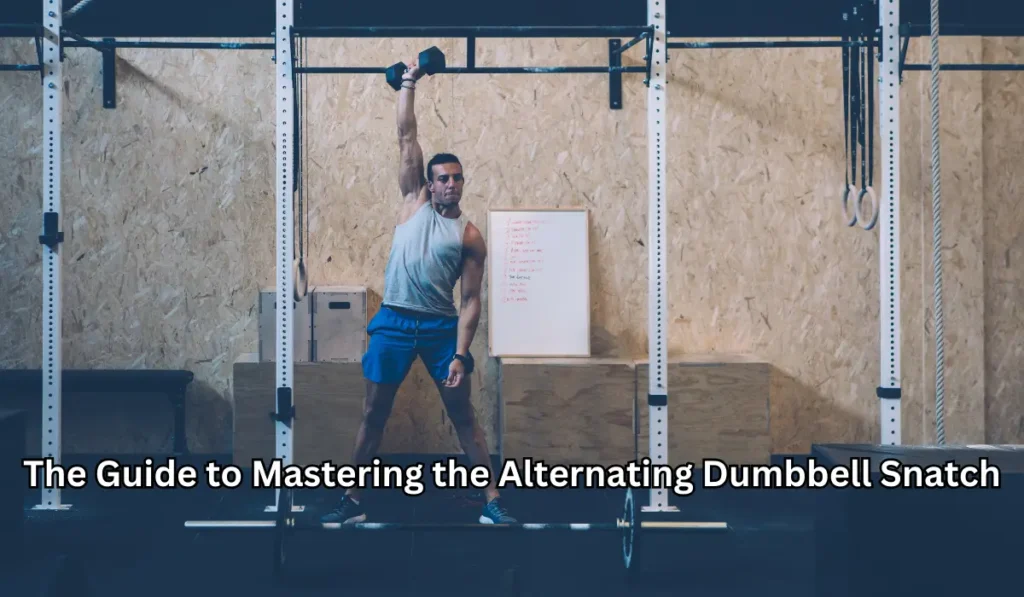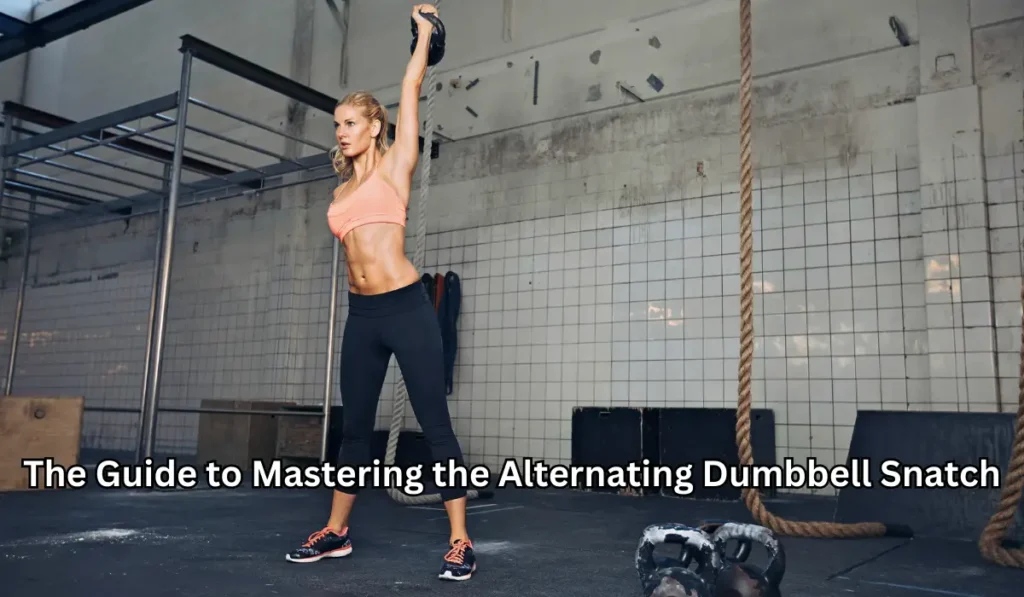
The Guide to Mastering the Alternating Dumbbell Snatch
The dumbbell snatch is a challenging full-body exercise that targets the upper and lower body muscles, including the shoulders, back, legs, and core. It requires strength, speed, and coordination to execute correctly. One variation of this exercise is the dumbbell snatch, which involves lifting the weight with one hand and then switching to the other hand in a continuous motion.
While it may seem intimidating, the alternating dumbbell snatch can be a great addition to your workout routine if done correctly. It can improve your power and explosiveness, enhance your endurance, and help you build muscle mass. However, without proper form and technique, you risk injury and may not get the full benefits of the exercise.
In this post, we will provide a comprehensive guide on how to perform the dumbbell snatch correctly. We will cover the proper form, step-by-step instructions, and tips to help you execute the exercise safely and effectively. Whether you’re a beginner or an experienced lifter, you’ll find valuable information to help you master this challenging exercise and take your fitness to the next level.
What is Dumbbell Snatch Exercise?
The dumbbell snatch exercise is a full-body movement that involves lifting a weight from the floor to overhead in a continuous motion, using one arm at a time. The exercise requires strength, power, and coordination to execute properly, and targets the muscles in the shoulders, back, legs, and core.
The dumbbell snatch has become increasingly popular in recent years, particularly in the CrossFit community, as a way to build strength and improve athletic performance. It is also used by Olympic weightlifters as a training exercise to improve their technique and explosive power.
The exercise can be done with a variety of weights, from light dumbbells for beginners to heavy weights for experienced lifters. However, proper form and technique are crucial to prevent injury and get the full benefits of the exercise.
Read about Does Pre Workout Break a Fast
Muscles Worked
The dumbbell snatch is a full-body exercise that engages multiple muscle groups. Here are the main muscles worked during the exercise:
- Shoulders – The deltoids are heavily involved in lifting the weight overhead and stabilizing it at the top of the movement.
- Back – The upper and lower back muscles, including the lats and erector spinae, are used to initiate the upward pull of the weight and maintain a straight spine throughout the movement.
- Legs – The glutes, quadriceps, and hamstrings are all involved in the explosive leg drive needed to lift the weight from the ground and into an overhead position.
- Core – The abdominals and obliques play a crucial role in stabilizing the torso throughout the movement and preventing excessive twisting or bending.
In addition to these primary muscle groups, the dumbbell snatch also engages smaller stabilizer muscles in the arms, wrists, and hands, making it a highly effective exercise for building overall strength and power.

Proper Form and Technique
Step-by-Step Instructions
The one-arm dumbbell snatch is a dynamic movement that requires proper form and technique to be executed safely and effectively. Here are step-by-step instructions on how to perform the exercise:
- Begin by standing with your feet shoulder-width apart and the dumbbell on the ground in front of you. Your toes should be pointed slightly outward.
- Bend down and grip the dumbbell with one hand, keeping your chest up and your back straight.
- In one smooth motion, drive through your legs and hips to lift the dumbbell off the ground and bring it up to shoulder height.
- As the dumbbell reaches shoulder height, continue to press it overhead, locking out your elbow at the top of the movement.
- Lower the dumbbell back down to the starting position by reversing the motion, keeping your chest up and your back straight.
- Repeat the exercise for the desired number of reps, then switch hands and repeat with the other arm.
Read about Tips for Achieving a 400lb Bench Press
Tips on How to Execute Each Step Correctly
To perform the one-arm dumbbell snatch correctly, it’s important to focus on proper form and technique. Here are some tips on how to execute each step correctly:
- Begin with a light weight: If you’re new to the one-arm dumbbell snatch, start with a light weight to master the movement and avoid injury.
- Keep your chest up and your back straight: Throughout the exercise, maintain good posture by keeping your chest up and your back straight. This will help you avoid injury and engage your core muscles.
- Use your legs and hips: The power for the exercise comes from your legs and hips, not your arms. Be sure to drive through your legs and hips to lift the weight and bring it up to shoulder height.
- Keep the dumbbell close to your body: As you lift the weight, keep it as close to your body as possible. This will help you maintain control and avoid injury.
- Use a full range of motion: To get the full benefits of the exercise, use a full range of motion by bringing the weight all the way up to shoulder height and pressing it overhead.
Common Mistakes to Avoid
When performing the one-arm dumbbell snatch, there are several common mistakes to avoid. Here are some of the most important ones:
- Using too heavy of a weight: Using a weight that is too heavy can lead to poor form and increase the risk of injury. Start with a light weight and work your way up.
- Rounding your back: Rounding your back during the exercise can put unnecessary strain on your spine and increase the risk of injury. Keep your back straight throughout the movement.
- Not using your legs and hips: Using only your arm to lift the weight can lead to poor form and limit the effectiveness of the exercise. Use your legs and hips to generate power.
- Letting the weight pull you forward: Allowing the weight to pull you forward can lead to poor form and increase the risk of injury. Keep the weight close to your body throughout the movement.
- Not using a full range of motion: Using a partial range of motion can limit the effectiveness of the exercise and increase the risk of injury. Use a full range of motion to get the full benefits of the exercise.
Variations and Modifications
There are several variations and modifications of the one-arm dumbbell snatch that can be used to increase or decrease the difficulty of the exercise, as well as to accommodate for injuries or physical limitations. Here are some of the most common variations and modifications, along with a detailed discussion of each:
- Kettlebell Snatch: The kettlebell snatch is similar to the one-arm dumbbell snatch, but uses a kettlebell instead of a dumbbell. The main difference is in the grip and the way the weight is held, which can change the way the exercise feels and engages the muscles.
- Alternating Snatch: The alternating snatch is a variation of the one-arm dumbbell snatch that involves switching hands with each repetition. This can add an additional challenge to the exercise by requiring more coordination and control.
- Hang Snatch: The hang snatch involves starting the exercise from a standing position, with the weight already lifted to shoulder height. This can be a good variation for beginners who need to work on their form and technique before attempting the full movement from the ground.
- Dumbbell Snatch with Jum: The dumbbell snatch with jump involves adding a vertical jump at the end of the movement, which can increase the difficulty and add a cardiovascular component to the exercise.
- One-Arm Dumbbell Snatch from a Deficit: The one-arm dumbbell snatch from a deficit involves standing on a raised platform or block, which increases the range of motion and engages the muscles in a different way.
- Dumbbell Snatch with Burpee: The dumbbell snatch with burpee combines the one-arm dumbbell snatch with a burpee, creating a full-body exercise that can increase cardiovascular endurance and strength.
- Single-Arm Dumbbell Snatch: The single-arm dumbbell snatch is similar to the one-arm dumbbell snatch, but involves using both hands to grip the weight instead of just one. This can be a good modification for individuals who need extra support or stability.
- Snatch from a Hang Position: The snatch from a hang position involves starting the exercise with the weight at hip height instead of on the ground. This can be a good variation for individuals who have difficulty lifting the weight from the ground.
Incorporating these variations and modifications into your workout routine can help you target different muscles, increase the difficulty of the exercise, or accommodate for injuries or physical limitations. However, it’s important to always prioritize proper form and technique, and to choose variations that are appropriate for your fitness level and goals.

Benefits of the Alternating Dumbbell Snatch
The alternating dumbbell snatch is a highly effective exercise that offers numerous benefits for strength, power, and overall fitness. Here are some of the main benefits of the exercise, along with a detailed discussion of each:
- Builds Full-Body Strength: The snatch is a full-body exercise that engages multiple muscle groups, including the shoulders, back, legs, and core. By working these muscles in a coordinated and explosive manner, the exercise can help build overall strength and power.
- Improves Cardiovascular Endurance: The exercise is a high-intensity exercise that can get your heart rate up and challenge your cardiovascular endurance. By incorporating exercise into your workout routine, you can improve your aerobic capacity and stamina.
- Increases Explosiveness and Power: The exercise requires explosive power to lift the weight from the ground and bring it overhead in one fluid motion. By training this explosive power, you can improve your overall athleticism and performance in other sports and activities.
- Enhances Coordination and Balance: It requires coordination and balance to execute properly. By practicing the exercise, you can improve your neuromuscular control and proprioception, which can translate to better balance and coordination in other movements and activities.
- Promotes Muscle Hypertrophy: It is a high-volume exercise that can promote muscle hypertrophy and growth, particularly in the shoulders, back, and legs. By incorporating exercise into your workout routine, you can target these muscle groups and achieve a more muscular and defined physique.
- Burns Calories and Promotes Weight Loss: It is a high-intensity exercise that can burn a significant amount of calories in a short amount of time. By incorporating exercise into your workout routine, you can boost your metabolism and promote weight loss.
Incorporating the alternating dumbbell snatch into your workout routine can provide numerous benefits for strength, power, and overall fitness. However, it’s important to always prioritize proper form and technique and to gradually increase the difficulty and volume of the exercise over time.
Read about Fitness Results with Ryan Hughes Workouts
Conclusion
In conclusion, the alternating dumbbell snatch is a highly effective exercise that offers numerous benefits for strength, power, and overall fitness. By engaging multiple muscle groups in a coordinated and explosive manner, the exercise can help build full-body strength, improve cardiovascular endurance, increase explosiveness and power, enhance coordination and balance, promote muscle hypertrophy, and burn calories for weight loss.
To get the full benefits of the exercise, it’s important to always prioritize proper form and technique and to gradually increase the difficulty and volume of the exercise over time. Additionally, incorporating variations and modifications of the exercise can help you target different muscles, increase the difficulty of the exercise, or accommodate for injuries or physical limitations.
Overall, the dumbbell snatch is a challenging and dynamic exercise that can help take your fitness to the next level. By incorporating it into your workout routine, you can build strength, power, and endurance while achieving a more muscular and defined physique.
